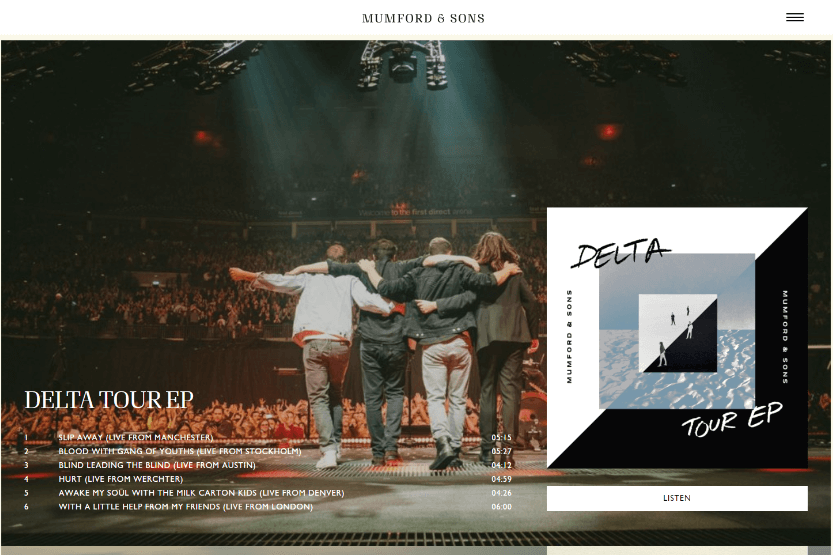Mumford & Sons is a British folk-rock band known for their unique sound and use of traditional instruments.
The band members play a variety of instruments, including acoustic guitar, drums, keyboard instruments, bass guitar, and traditional folk instruments such as banjo, mandolin, and resonator guitar.
The band’s name comes from Marcus Mumford, who is the most visible member and is responsible for organizing the band and their performances.
One of the most interesting aspects of Mumford & Sons is their use of traditional instruments in their music.
The band’s sound is heavily influenced by traditional folk music, and they often incorporate instruments such as the banjo, mandolin, and resonator guitar into their songs. This gives their music a unique sound that sets them apart from other modern rock bands.
If you’re a fan of Mumford & Sons and are interested in learning more about the instruments they use in their music, there are a variety of resources available.
From interviews with the band members to online forums and fan communities, there are plenty of opportunities to explore the world of Mumford & Sons and their unique sound.
What Type of Music is Mumford and Sons?

Mumford and Sons is a British folk-rock band that was formed in 2007. The band members play a variety of instruments including acoustic guitar, drums, keyboard instruments, bass guitar, and traditional folk instruments such as banjo, mandolin, and resonator guitar.
The band’s sound is characterized by its raucous, fast-paced, and sonically dense instrumentation.
The band’s lyrics often have a spiritual focus subtly grounded in Christianity. Their best-known songs, such as “Little Lion Man,” “I Will Wait,” “Lover of the Light,” and “Believe” are a fusion of bluegrass, folk, country, and rock, which have found favor with audiences both at home and abroad.
Marcus Mumford, the lead singer and songwriter of the band, is known for his distinctive voice and his ability to write lyrics that are both introspective and relatable.
Ben Lovett, the keyboardist and backing vocalist, adds depth and texture to the band’s sound with his use of various keyboard instruments. Ted Dwane, the bassist, is known for his melodic and driving basslines, which provide the backbone for the band’s music.
Winston Marshall, the banjo player and guitarist, adds a unique flavor to the band’s sound with his use of traditional folk instruments.
Overall, Mumford and Sons’ music is characterized by its unique fusion of traditional folk instruments and modern rock and pop influences. Their sound is both energetic and introspective, and their lyrics often explore themes of love, loss, and spirituality.
Instruments Used

Mumford & Sons is known for their unique sound that blends traditional folk instruments with modern rock elements. The band uses a variety of instruments that contribute to their signature sound. Here are some of the instruments used by the band:
Guitars
Guitars are a staple in Mumford & Sons’ music. The band uses both acoustic and electric guitars. Marcus Mumford, the lead singer and guitarist, often plays a Gibson J-45 acoustic guitar.
Winston Marshall, the banjo and guitar player, uses a variety of electric guitars, including a Fender Telecaster and a Gibson Les Paul.
Banjo
The banjo is another essential instrument in Mumford & Sons’ music. Winston Marshall is the band’s banjo player and is known for his fast and intricate playing style.
He plays a Deering Sierra banjo with a Kavanjo pickup. However, as per the Los Angeles Times, the brand dropped the banjo in 2015.
Keyboard
Keyboard instruments are used to add depth and texture to the band’s music. Ben Lovett, the band’s keyboard player, uses a variety of instruments, including a Nord Electro 3, a Yamaha CP70, and a Wurlitzer electric piano.
Drums
Drums are a crucial element in Mumford & Sons’ music, providing the driving rhythm that propels the songs forward. The band’s drummer, Chris Maas, plays a Ludwig drum kit with Zildjian cymbals.
Other Instruments
Mumford & Sons also use a variety of other instruments to create their unique sound. These include:
- Mandolin: The mandolin is a small, stringed instrument that is used in many of the band’s songs. Winston Marshall is the band’s mandolin player.
- Resonator guitar: The resonator guitar is a type of acoustic guitar that uses a metal resonator cone to amplify the sound. Marcus Mumford plays a National Reso-Phonic resonator guitar.
- Fiddle: The fiddle is a stringed instrument that is similar to a violin. Mumford & Sons use the fiddle to add a traditional folk element to their music.
- Ukulele: The ukulele is a small, four-stringed instrument that is used in some of the band’s songs.
What Wooden Instrument is Used in Mumford and Sons?
As per the Last FM, Mumford and Sons is known for their use of traditional instruments, including the banjo, mandolin, and accordion. However, one of the most recognizable instruments in their music is the wooden instrument known as the acoustic guitar.
The acoustic guitar is a wooden instrument that has been used in music for centuries. It is a stringed instrument that produces sound by vibrating the strings when they are plucked or strummed.
The guitar has a hollow body that amplifies the sound produced by the strings, making it one of the most versatile and popular instruments in modern music.
In Mumford and Sons’ music, the acoustic guitar is often used to create a driving rhythm that propels their songs forward. The band’s unique style of folk-rock relies heavily on the use of acoustic instruments, and the guitar is a key component of their sound.
Whether it’s the driving rhythm of “Little Lion Man” or the haunting melody of “I Will Wait,” the acoustic guitar is an essential part of Mumford and Sons’ music.
Albums and Notable Songs

Mumford & Sons has released four studio albums, each with its unique sound and style. Here are some highlights from each album:
Sigh No More
Released in 2009, Sigh No More was Mumford & Sons’ debut album. It features a blend of folk, rock, and bluegrass elements that helped define the band’s signature sound. The album received critical acclaim and was nominated for Album of the Year at the 2011 Grammy Awards.
Notable songs from Sigh No More include “Little Lion Man,” “The Cave,” and “I Will Wait.” “Little Lion Man” was the band’s breakthrough single and features powerful lyrics and a driving banjo riff.
Babel
Mumford & Sons’ second album, Babel, was released in 2012. It continues the band’s folk-rock sound while incorporating more electric instruments and a wider range of influences. Like Sigh No More, Babel was nominated for Album of the Year at the Grammy Awards and won the award in 2013.
Notable songs from Babel include “I Will Wait,” “Lover of the Light,” and “Whispers in the Dark.” “I Will Wait” is a fan favorite and features a catchy melody and uplifting lyrics.
Wilder Mind
Wilder Mind, released in 2015, marked a departure from Mumford & Sons’ previous albums. The band traded their acoustic instruments for electric ones and embraced a more rock-oriented sound.
The album received mixed reviews from critics but still managed to debut at number one on the UK Albums Chart.
Notable songs from Wilder Mind include “Believe,” “The Wolf,” and “Snake Eyes.” “Believe” is a standout track with a soaring chorus and introspective lyrics.
Delta
Mumford & Sons’ most recent album, Delta, was released in 2018. It features a mix of the band’s traditional folk elements and the more experimental sound they explored on Wilder Mind. The album received positive reviews and debuted at number one on the UK Albums Chart.
Notable songs from Delta include “Guiding Light,” “If I Say,” and “Woman.” “Guiding Light” is a standout track with an anthemic chorus and uplifting lyrics.
Overall, Mumford & Sons’ albums showcase the band’s ability to blend folk, rock, and bluegrass elements into a unique and powerful sound. Each album has its own distinct style and highlights the band’s growth and evolution over the years.
In Closing
Mumford & Sons’ unique sound is largely due to their use of various instruments, including the banjo, which has become somewhat of a signature sound for the band.
The banjo, along with other instruments such as the double bass and piano, creates a distinctive folk-rock sound that sets the band apart from others in the genre.
While the band is known for their use of the banjo, they also incorporate other instruments in their music, such as the accordion and mandolin. This versatility allows the band to experiment with different sounds and create a diverse range of music that appeals to a wide audience.
Overall, Mumford & Sons’ use of instruments is a key component of their success and has helped to establish them as one of the most popular folk-rock bands in the world. Whether it’s the banjo, double bass, or piano, the band’s unique sound is a testament to their creativity and musical talent.







![Read more about the article What Are the Most Popular Instruments? [10 Top]](https://musicalinstrumentpro.com/wp-content/uploads/2021/02/most-popular-instruments-300x200.jpg)

![Read more about the article What Is the Easiest Instrument to Learn? [10 Easy Musical Instruments]](https://musicalinstrumentpro.com/wp-content/uploads/2020/11/what-is-the-easiest-instrument-to-learn-to-play-300x200.jpg)